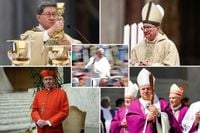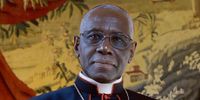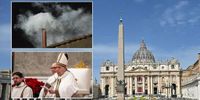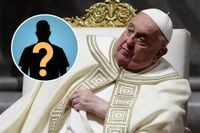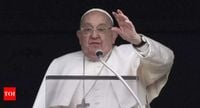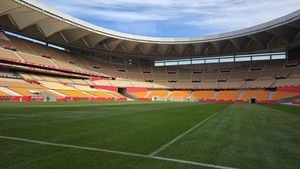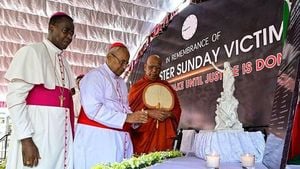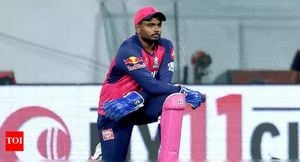The death of Pope Francis has surprised many, leaving questions about who could be the next representative of the Vatican. His sudden passing has left many doubts about who could be next. According to Diario de Sevilla, Robert Sarah, prefect emeritus of the Congregation for Divine Worship and the Discipline of the Sacraments, is originally from Ourous, Guinea. At 79 years old and with a distinguished international career, he remains an influential figure. There is also Matteo Zuppi, Archbishop of Bologna, Italy, born in Rome and 69 years old. He is one of the most relevant figures within the Italian Catholic Church.
Luis Tagle, born in Manila, Philippines, is 67 years old and serves as pro-prefect of the Dicastery for Evangelization; his global profile makes him a strong candidate. Malcolm Ranjith, Metropolitan Archbishop of Colombo in Sri Lanka, is originally from Polgahawela and, at 77 years old, enjoys great respect on the Asian continent. Pietro Parolin, current Secretary of State of the Vatican, was born in Schiavon, Italy, and at 70 years old is one of the most mentioned names in speculations about the next pontiff. Also considered relevant figures are Pierbattista Pizzaballa, Latin Patriarch of Jerusalem; Péter Erdő, Metropolitan Archbishop of Esztergom-Budapest in Hungary; Willem Eijk, Metropolitan Archbishop of Utrecht in the Netherlands; Fridolin Ambongo Besungu, Archbishop of Kinshasa, from the Democratic Republic of the Congo; Anders Arborelius, Bishop of Stockholm in Sweden; Charles Bo, Archbishop of Yangon in Myanmar; and Jean-Marc Aveline, Metropolitan Archbishop of Marseille in France. However, others point to Angelo De Donatis. At 70 years old, this Italian cardinal has accumulated extensive experience within the Catholic Church.
Until recently, he served as Archpriest of the Basilica of St. John Lateran and Vicar General of the Diocese of Rome. In January 2024, he was appointed Major Penitentiary by Pope Francis, filling the position left vacant by Cardinal Mauro Piacenza.
Pope Francis died of bilateral pneumonia, which is "one of the most serious complications that can affect people." Pneumonia is a condition that involves inflammation of lung tissue, usually caused by microorganisms that enter the respiratory system. This condition often affects both lungs simultaneously, and its severity can vary widely. While in some cases it doesn't present obvious symptoms, in others it can cause mild or moderate discomfort. It can even lead to critical situations requiring specialized respiratory support.
His death comes as the Catholic Church prepares for a significant transition. Cardinal Kevin Farrell announced Pope Francis' death at 7:35 a.m. (0535 GMT) on April 21, 2025, a day after making a much hoped-for appearance at Saint Peter’s Square on Easter Sunday. “Dearest brothers and sisters, it is with deep sorrow that I must announce the death of our Holy Father Francis,” said Cardinal Farrell in a statement published by the Vatican on its Telegram channel. “This morning at 7:35 a.m. (0535 GMT) the Bishop of Rome, Francis, returned to the home of the Father.”
Now, all eyes turn to the Vatican, where the process of selecting his successor is officially underway. After officially confirming the pope’s death, Cardinal Farrell, Pope Francis’ camerlengo, must now prepare the funeral. The camerlengo and three assistants then decide when the pope’s coffin will be taken into St. Peter’s Basilica for public viewing, and also make sure his “Fisherman’s Ring” and lead seal are broken so they cannot be used by anyone else. No autopsy is performed. Mourning rites last nine days, with the date of the funeral and burial to be decided by the cardinals. The funeral would normally be held four to six days after the death, in St. Peter’s Square. Pope Francis had said that unlike many predecessors, he would not be laid to rest in the crypt of St. Peter’s Basilica, but in Rome’s St. Mary Major Basilica. He also asked to be buried in a simple wooden casket.
With the papal seat now vacant, the Church enters “sede vacante” – Latin for “the seat being vacant.” During this period, the day-to-day operations of the Holy See are overseen by the College of Cardinals, who have limited power, and much of the central church administration grinds to a halt. Preparations for the election of the next pope begin immediately.
The responsibility of choosing the next pope falls to the College of Cardinals, specifically those under the age of 80 – currently 137 members. They will gather in strict secrecy inside the Sistine Chapel for what is known as a conclave. The conclave to elect a new pope starts in chapel between 15 and 20 days after the death. The cardinals, who are confined to the Vatican for the duration of the conclave, decide the exact day. Each cardinal elector casts secret ballots up to four times daily. To be elected pope, a candidate must receive a two-thirds majority. The world learns a pope has been elected when an official burns the paper ballots with special chemicals to make white smoke pour from the chapel’s chimney. They use other chemicals to make black smoke, which indicates an inconclusive vote. When the election is concluded, the new pope is asked if he accepts and what name he wishes to take. The dean of the College of Cardinals steps onto the central balcony of St. Peter’s Basilica to announce “Habemus Papam” – which means “We have a pope.” The new pope then appears and gives the crowd in the square his blessing.
In the months following Pope Francis’ declining health, certain cardinals have been widely considered to be front-runners in the case of his death. Here are the top front-runners: Cardinal Pietro Parolin (Italy): Vatican Secretary of State and a seasoned diplomat, Parolin has been central to key negotiations, including the Vatican’s deals with China and Cuba. Cardinal Luis Antonio Tagle (Philippines): Known for his pastoral approach and global appeal, Tagle embodies many of Francis’ values, including humility and outreach to the poor. Cardinal Peter Turkson (Ghana): A potential choice for the first African pope in over 1,500 years, Turkson is a prominent voice on climate change and social justice. Cardinal Robert Sarah (Guinea): Representing a more conservative wing, Sarah is known for his traditionalist theological positions. Francis’ influence on the next conclave will be significant, according to reports. More than 70 percent of the cardinal electors were appointed by him, which may favor a successor who shares his vision of a more inclusive, globally representative church.
The next Pope could come from Africa, Italy, or Sri Lanka — possibly even America — but it’s likely that whoever is elected to follow Pope Francis will nudge the Catholic Church back to the ideological center, experts said. During Francis’ 12-year reign leading the world’s 1.4 billion Catholics, the late pope’s support for LGBTQ Catholics and suppression of the traditional Latin Mass were among moves that rankled conservatives in the church. Now, “whoever is elected will be of a centrally conservative disposition; after 12 years of Pope Francis ‘stirring things up,’” said Serenhedd James, editor of Britain’s Catholic Herald magazine. “I think the cardinals will want someone who will take a different, calmer approach.”
